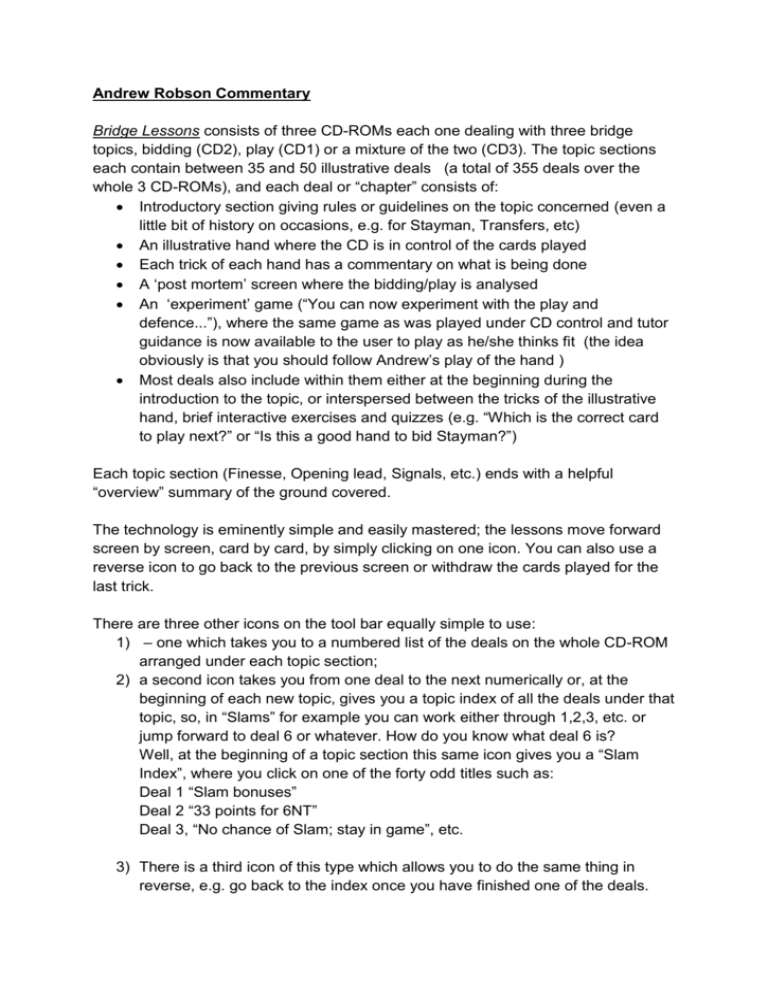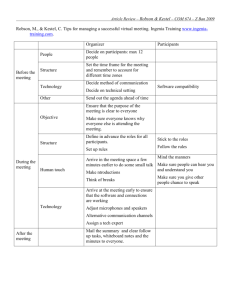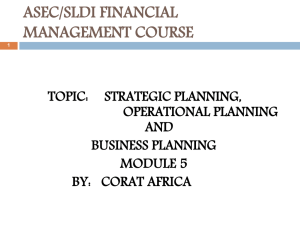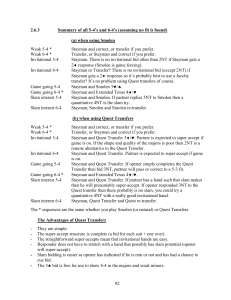Andrew Robson Commentary Bridge Lessons consists of three CD
advertisement

Andrew Robson Commentary Bridge Lessons consists of three CD-ROMs each one dealing with three bridge topics, bidding (CD2), play (CD1) or a mixture of the two (CD3). The topic sections each contain between 35 and 50 illustrative deals (a total of 355 deals over the whole 3 CD-ROMs), and each deal or “chapter” consists of: Introductory section giving rules or guidelines on the topic concerned (even a little bit of history on occasions, e.g. for Stayman, Transfers, etc) An illustrative hand where the CD is in control of the cards played Each trick of each hand has a commentary on what is being done A ‘post mortem’ screen where the bidding/play is analysed An ‘experiment’ game (“You can now experiment with the play and defence...”), where the same game as was played under CD control and tutor guidance is now available to the user to play as he/she thinks fit (the idea obviously is that you should follow Andrew’s play of the hand ) Most deals also include within them either at the beginning during the introduction to the topic, or interspersed between the tricks of the illustrative hand, brief interactive exercises and quizzes (e.g. “Which is the correct card to play next?” or “Is this a good hand to bid Stayman?”) Each topic section (Finesse, Opening lead, Signals, etc.) ends with a helpful “overview” summary of the ground covered. The technology is eminently simple and easily mastered; the lessons move forward screen by screen, card by card, by simply clicking on one icon. You can also use a reverse icon to go back to the previous screen or withdraw the cards played for the last trick. There are three other icons on the tool bar equally simple to use: 1) – one which takes you to a numbered list of the deals on the whole CD-ROM arranged under each topic section; 2) a second icon takes you from one deal to the next numerically or, at the beginning of each new topic, gives you a topic index of all the deals under that topic, so, in “Slams” for example you can work either through 1,2,3, etc. or jump forward to deal 6 or whatever. How do you know what deal 6 is? Well, at the beginning of a topic section this same icon gives you a “Slam Index”, where you click on one of the forty odd titles such as: Deal 1 “Slam bonuses” Deal 2 “33 points for 6NT” Deal 3, “No chance of Slam; stay in game”, etc. 3) There is a third icon of this type which allows you to do the same thing in reverse, e.g. go back to the index once you have finished one of the deals. So the whole “syllabus” is readily accessible and flexible in accordance with whatever the user wishes to consult. On the “experiment hands” at the end of each deal you are able to pick the card to play by clicking on the card itself which gives that section of each deal more authenticity. (You don’t even need to choose the lead that the computer highlights – in fact it’s interesting sometimes to try a different lead card and see what the consequences are!) The contents of the CDs are what Robson says they are in the Foreword to each CD – an interactive book. So they are not ‘Bridge problems’ nor were they designed from the start as computer programmes, like some other products on the market (the Mr Bridge series of CDs, for example). These CDs are interactive versions of Robson’s nine bridge booklets mentioned on the CD covers. Now I haven’t seen any of these booklets in the printed version, but it is important to judge the CDs simply as what they say they are – as books made interactive. The CDs offer numerous advantages over the book format. First of all, drawing on my own experience and I have heard that this is the experience of others too, I find it difficult to concentrate for long on books about bridge. Even with accessible authors like Paul Mendelson, the effort of translating numbers on the page into actual hands or working through games set out in print on the page can become tiring. Although I haven’t read the booklets, and it’s true, with Robson’s style it could be different, with this interactive version I found I was able to continue for a sustained period of time working through the materials without losing concentration. For one thing the hands on the CDs are colourfully and attractively presented. I am familiar with the internet version of Bridge Base on Line, so the layout was not entirely new to me, but the clear ‘bidding boxes’ in yellow and other colours, the option to use numbered hands or actual images of the cards themselves (and very attractive cards at that!) enlivened the learning and playing process enormously in comparison with black and white words and images on a page. In addition, where there is text, this is never intensively presented as too much to digest; it is either brought in gradually as a sort of ‘Power Point’ presentation, (short )paragraph by (short) paragraph, or introduced at the bottom of the screen in support of the layout of the cards. The type font chosen is eminently legible, so in presentational terms the materials score highly over book format. The touches of humour, too (e.g. “You can even signal that you want to take the dog for a walk” in the Introduction to “Signals and Discards” or the “If someone stops you in the street...” question at Stayman deal 11 or the “Ryanair special” in Squeeze deal 22) along with potted histories and anecdotes drawn from Andrew’s own experiences and games add to the enjoyment! The CD’s are not, I think, aimed at the basic or beginner player. They do not go into concepts which Robson uses elsewhere such as “responder line” or the “support line”, as explained in his Bridge – Common Mistakes and How to Avoid Them which is “aimed at the social or less experienced player”.. These CDs are aimed at the “improver” level or beyond since they assume a good deal of basic knowledge about bidding and play. For example the “Overcall” topic opens with a number of short exercises which go beyond the basics of holding a five card suit, having 8 – 15 points, and so on, and focus on things like suit quality, tactics, etc. Having said that, the wide range of illustrative deals within each topic means that the ‘improver’ is sure to find deals which practise topics s/he is already familiar with alongside techniques of bidding and play which break new ground. Furthermore, the standard pattern of each deal unit (explanation/exercises/illustrative hand/post mortem/ experiment hand) means that there is enough material even within each deal to be able to work through several times if necessary until you feel you have mastered it. I was certainly glad to be able to do this and again, the simple technology made it easy. Before going on to a few detailed comments on some of the deals themselves it’s worth noting perhaps some minor criticisms of the materials. The biggest negative, perhaps, is that you never actually get to fully play the hands as if you were a genuine player without knowledge of the opposition’s cards. This is because in the “experiment hands” at the end of each section all the hands are open and on the table. Now the advantage of this, as Robson says in the caption to those hands, is that you “experiment with the play and defence” too. But at the same time, as you play each trick, you do have to look at all the cards held by all the players, so, for example, you will know the distribution of the cards, you know where there are touching honours or tenaces and inevitably you use this information during play. This detracts a little from the ‘authenticity’ of being able to choose your cards, which I mentioned above. Ironically, in the illustrated play section of each deal you do only see your hand and dummy. It would be good to feel rewarded at the end of each deal by being able to play it (hopefully successfully) yourself. This would give you feedback on how successful the lesson has been for you. And talking of rewards – a small point but I think worth mentioning in a learning context - it would be nice from time to time to have a “well done” or “good play” appear on the screen; this particularly in the exercises, where one is ‘rewarded’ only with ‘That is the correct answer’ (admittedly with a friendly ‘ping’ if you have your sound turned on). Or, if you give a wrong answer, I think a bit of feedback on why it is wrong rather than just ‘That is not the correct answer’. This is particularly true of the “Tell me” button, where, again, you may just be told what the correct answer is without any supporting rationale. The final point of criticism is that I found the pace of play a bit slow. Now, of course, this does give you time to reflect on the play you have just seen or (in the case of the illustrated play by the CD) guess what the next card to be played might be. But if it were possible, without overcomplicating the technology, to give the user the chance of speeding up the play where s/he wanted to do so, this could be an advantage. Playing with the numbers in boxes rather than the ’virtual cards’ did appear a little faster, especially in the ‘undo’ but even here it was (sometimes!) too slow. Comments on some actual themes and chapters (highly selective!) CD1 – Finesse, Opening Lead, Signal and Discard Finesse Deal 4 underlines the “common mistake” of leading the card you want to promote instead of leading towards it. Robson returns to this topic at other points in the CDs , showing the way he reinforces important rules. The finesse “Overview” section is particularly helpful, showing a variety of situations where different finesses techniques are required. The first deal of “Opening Lead” refers to an experience Robson had in his club, which becomes a recurrent theme over this topic section. These examples derived from real play make the sections entertaining as well as informative. With deal 36 of “Opening Leads” Robson warns that this is more advanced (which is helpful); but he gives some important tips for using the auction as a clue to which card to lead; The only misprint I found was in the Opening leads Overview (p.2) – ‘No Trump contracts’ is written as ‘Nottump’ Helpful definitions in Deals 3 & 4 of “Signal & Discard” ‘What is a signal’ and ‘When is your card a signal?’ But I did not find so helpful the distinction he makes in the two ‘ditties’ “Throw High means Aye: Throw Low means no” for signals and “Lead low for like, lead high for hate” for leads which appears to contradict his “Reverse attitude” recommendation in his book Bridge – Common Mistakes and How to Avoid Them (p.205) CD2 - Double, Overcall, Slam Robson always makes his assumptions clear, as in “Double” Deal 13 “At this stage in the programme I am assuming that we are not playing such gadgets as the negative double” Overcall Deal 13 sets out the principle; deals 13 – 19 illustrate it; this patterns (seen elsewhere too) gives the user plenty of chance to practise, and at different degrees of difficulty; One of the big issues for slam bidding is whether to go for it or not. Robson’s very clear rules (Deals 4 - 6) take the guess work out of the dilemma and then Blackwood is fully covered in Deals 7 -11, while 12 presents an excellent summary: this is typical of the “graded” presentation these materials are so good at. The programme uses screen to advantage that could not be captured in a book; one of these techniques is suspense as in “Overcall” Deal 27 – one screen has the problem; the other the solution; see also Deal 29’s “Beware!” The CD devotes a good amount of space to splinter bids but the occasional non-interactive exercises in this section (e.g. deal 26, deal 32) are not so satisfying Throughout the CDs there are continual summaries, reiterations and reminders, which is excellent; slam deal 12 “tools to date” is a good example CD3 - Stayman & Transfer, Weak Two, Endplay and Squeeze Stayman Deal 6 (and others) – Robson points out a greater rationale for using Stayman, and demonstrates (convincingly over a number of deals in the section) that Stayman can very often be the only means of finding a fit. A good number of exercises interspersed in the illustrative hands during the Stayman section asking the user to decide if Stayman is the right bid or not Transfers, deal 3 shows what can happen (as we all know!) when your partner does not realise you are making a transfer (“You must not forget!”) It’s good to have these “common mistake” hands alongside the correct play. The introduction to Weak Twos (Deal 1) provides an interesting historical perspective through to the introduction of Benji (Deal 2); “Endplay” and “squeeze” are two areas I am not yet familiar with, but here again one notes Andrew making them accessibility by breaking them down into their components of ‘Elimination’ and ‘throw-in’ for endplay (deals 2 – 11), and the remarkably clear set of options presented step by step in deal 19 for the ‘Squeeze’ Finally, anyone who plays on the internet using Bridge Base on Line. will, after using these three CDs - which borrow the same presentational format - feel much more confident in using that medium as the “reality beyond the practice”. But for whatever Bridge situation, these materials provide an excellent grounding for anyone at any level, from improver to advanced, to identify their weaknesses, and gain a real understanding of how the game should be played.





